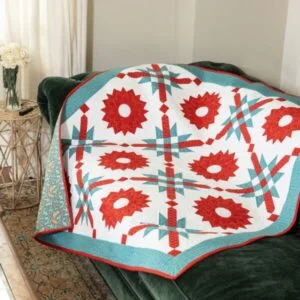The Log Cabin Variation Quilt – Tutorial is a fresh twist on a classic quilting pattern, allowing for creativity and customization. This tutorial will guide you through the steps of crafting your own Log Cabin Variation Quilt, giving you the confidence to explore new layouts and color schemes. Whether you’re a beginner or an experienced quilter, this project offers a satisfying way to create a beautiful, modern quilt.
The Log Cabin Variation Quilt takes the traditional log cabin block and adapts it for a more dynamic design. Instead of uniform blocks, you’ll use different shapes and sizes to create a unique patchwork effect. This quilt is perfect for using up scrap fabrics or showcasing your favorite prints. The variation allows for a range of artistic interpretations, making each quilt a personal work of art.
In this tutorial, we’ll walk through the materials needed, step-by-step instructions, and tips for sewing the quilt. By the end, you’ll have a cozy and stylish quilt to brighten up your home. Let’s dive into the Log Cabin Variation Quilt – Tutorial!

1. Materials You Need for the Log Cabin Variation Quilt
Before starting on your Log Cabin Variation Quilt, it’s essential to gather all the materials. This project requires basic quilting supplies, but the key to success is selecting fabrics that coordinate well together. Whether you prefer vibrant colors or a more subdued palette, fabric selection will define the overall look of your quilt.
- Fabric: Choose a combination of light, medium, and dark fabrics. You’ll need a mix of solids and prints to give depth to the quilt design. The amount will depend on the size of your quilt.
- Batting: This is the middle layer that gives the quilt its warmth and thickness. Select a good quality batting for durability.
- Backing Fabric: The backing is the fabric used for the underside of your quilt. It can be a solid piece of fabric or pieced together for a more intricate design.
- Quilting Ruler: A ruler is necessary for cutting straight, accurate pieces.
- Rotary Cutter and Cutting Mat: These tools ensure precise cuts, which are crucial for a professional-looking quilt.
- Sewing Machine: Although you can sew a quilt by hand, a machine speeds up the process and ensures even stitching.
Once you have all your materials, you’re ready to begin!
2. Cutting the Fabric for Your Log Cabin Variation Quilt
Accurate cutting is the first step to a successful quilt. In the Log Cabin Variation Quilt, you’ll cut your fabric into various strip sizes to create the distinctive log cabin blocks. Follow these steps to prepare your fabric for assembly:
- Measure and Cut the Strips: Using your rotary cutter and quilting ruler, cut the fabric into strips. For a classic log cabin look, the strips can be 2 ½ inches wide, but feel free to adjust depending on your desired quilt size.
- Organize Your Strips: Keep the light, medium, and dark fabrics in separate piles. This will help with the placement of colors during the sewing process.
- Consider the Layout: You can choose a traditional log cabin layout, with light fabrics on one side and dark on the other, or experiment with more creative layouts by mixing up the placement.
- Trim as Needed: After cutting the initial strips, ensure all pieces are the same length. Consistent strip lengths are essential for even block construction.
- Work with Scraps: The beauty of the log cabin variation is that it’s great for using up leftover fabric scraps. Don’t hesitate to mix different textures and patterns.
- Mark Your Fabric: If you’re using directional fabric, mark the correct orientation with a fabric pencil to avoid mistakes when piecing the quilt.
Once your fabric is prepped and organized, you can begin the sewing process.
3. Assembling the Quilt Blocks
The assembly is where your Log Cabin Variation Quilt comes to life. This is the most creative step, allowing you to experiment with color placement and block sizes. Follow these tips for assembling your blocks efficiently:
- Start with a Center Square: Begin by cutting a small square for the center of each block. This can be a contrasting color or pattern to make the design stand out.
- Add the First Strip: Sew the first strip of fabric to one side of the center square. Use a ¼ inch seam allowance for all seams.
- Work Around the Center: Continue adding strips in a clockwise or counterclockwise direction. Alternate between light and dark fabrics to create the signature log cabin look.
- Press the Seams: After adding each strip, press the seams flat. This step ensures that your blocks lay flat and are easier to piece together later.
- Vary the Strip Lengths: For a variation on the classic log cabin, use strips of different lengths. This creates an asymmetrical look that adds interest to your quilt.
- Make Several Blocks: Depending on the size of your quilt, you’ll need multiple blocks. Each block should measure the same size when completed to make assembly easier.
Once your blocks are complete, you’re ready to join them together.
4. Finishing Your Log Cabin Variation Quilt
The final steps of your Log Cabin Variation Quilt include piecing the blocks together, adding batting and backing, and finishing with quilting and binding. Here’s how to complete your project:
- Arrange the Blocks: Lay out your blocks on a flat surface, experimenting with the placement until you’re happy with the design.
- Sew the Blocks Together: Join the blocks in rows, pressing the seams after each row is sewn. Then, sew the rows together to form the quilt top.
- Add the Batting and Backing: Lay the batting and backing fabric flat, with the quilt top on top. Pin the layers together to prevent shifting during quilting.
- Quilt the Layers: You can quilt by hand or machine, following the lines of the blocks or adding free-motion quilting for a more artistic look.
- Trim the Edges: After quilting, trim any excess batting and backing fabric to match the edges of the quilt top.
- Bind the Quilt: To finish the quilt, add binding around the edges. This can be a contrasting fabric or a coordinating color.
Congratulations! Your Log Cabin Variation Quilt is now complete.
FAQ
Q: What makes the Log Cabin Variation Quilt different from the traditional log cabin quilt?
A: The Log Cabin Variation Quilt uses different-sized strips and more creative layouts, offering a more modern and artistic take on the traditional log cabin design.
Q: What fabric should I use for a Log Cabin Variation Quilt?
A: You can use any quilting cotton, but it’s best to choose a mix of light, medium, and dark fabrics to create contrast in the blocks.
Q: Can I sew this quilt by hand?
A: Yes, while most people prefer to use a sewing machine, hand sewing is an option. It will take longer, but the result can be equally beautiful.
Q: How do I choose the best batting for my quilt?
A: For a winter quilt, use a thicker batting like cotton or wool. For a lighter, summer quilt, polyester batting works well.
Q: What size should the quilt be?
A: The size is entirely up to you! You can make a small lap quilt or a large bedspread, depending on your needs.
Q: How long does it take to complete a Log Cabin Variation Quilt?
A: The time it takes depends on your experience and how much time you dedicate to the project. On average, it can take a few weeks to a couple of months to complete.
Join our VIP broadcast list and gain access to exclusive patterns, all for free. As a VIP member, you’ll receive the best patterns daily, delivered directly to your device. ✨📱 It’s a unique opportunity to stay up-to-date with the latest trends and designs, curated just for you. Don’t miss out on enhancing your projects and discovering new inspirations with the best patterns every day! 🎨🔝
Conclusion
The Log Cabin Variation Quilt – Tutorial offers a creative and flexible approach to quilting that’s both fun and rewarding. By following this guide, you’ll be able to create a beautiful, one-of-a-kind quilt that showcases your style and craftsmanship. We hope this tutorial has provided all the information you need to get started on your quilt.
If you’ve enjoyed this tutorial or have any suggestions, we’d love to hear from you! Please leave a comment below and share your thoughts or tips. Happy quilting!



